The summer of 1997 was one I remember for i's rain, its
rain and sometimes its rain. As I picked my way through the
puddles and sheltered under umbrellas it seemed like we'd
never see the sun again. But now, a few months have passed
by, and as ever the bad memories fade. When I think of the
summer now I find myself casting my mind back to the time
when, just for a few days, I was transported back to the very
zenith of Victorian splendour - the celebrations of Queen
Victoria's Diamond Jubilee.
In the summer of 1897 the streets of London were packed
to bursting point as hundreds of thousands of enthusiastic
revellers descended on the capital for a gli~npse of what was
to be the high-water mark of Victoria s reign. One hundred
years later English Heritage decided to mark this historic
centenary by inviting Victorian reenactors from all around
the world to visit Britain anc take part in a series of
commemorative events, bringin history alive in the process.
And what a gathering it was from Australia, Canada and
Malta they came, to join on home-based groups.
So it was to Wrest Park in Bedfordshire, Richmond Castle
and Brodsworth Hall in Yorkshire as well as St. Paul's
Cathedral in London, that the scarlet and blue of Victoria's
soldiers, along with just a little khaki, would march once more.
It was the largest gathering of Victorian re-enactors ever seen
in this country. And like their forefathers who had made the
same, although somewhat slower trip, one hundred years
earlier, these "Sons of Empire" enjoyed every minute of it,
despite the rain. English Heritage should be warmly
congratulated on their tremendous efforts in bringing everyone
together for this unique celebration of Empire. It will be sad if
we have to wait another hundred years for their return.
PHOTO CAPTIONS
The Lancers are of course famous for their role in
the Charge of the Light Brigade and at Ulundi in
Zululand. The uniform and equipment of a trooper of
the 17th Lancers Display Team. The dark blue tunic,
based on the Polish Kurtha, has a reversible plastron
front, showing white or blue. The facings on collar
and cuffs are white and there is a double white stripe
down the outside trouser seams. The Polish influence
on lancer uniforms is also shown in the Chapka, the
square-topped helmet. The troopers are armed with a
9 Ft bamboo lance, 1885 pattern sword and .303
Martini-Metford carbine.
This article appears in MagWeb (Magazine Web) on the Internet World Wide Web.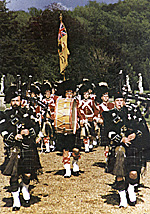 1: The skirl of the pipes and the beat of the drums resound
as the 78th Highland Regiment march past. The Highlanders
made the journey from Nova Scotia in Canada to take part in
the centenary celebrations and was the largest unit taking part
in the events, with almost fifty members present. The uniform
is that of the 78th Highlanders when they were based in Nova
Scotia between 1869-1871. The level of authenticity of the
Highlanders is remarkable. Years of research have been carried
out to ensure the uniforms and equipment are as close to the
original items as possible. 78th Highland Regiment. The unit is
based at the Halifax Citadel and is manned throughout the
summer months by a select group of university and high
school students who have to undergo rigorous testing before
they are accepted into the unit. Those who are successful
tend to serve on average for three seasons, which enables the
high standard of drill to be maintained. Each man carries
a Snider-Enfield breech-loading rifle and wears a feather
bonnet, doublet with buff facings and a kilt of MacKenzie
tartan.
1: The skirl of the pipes and the beat of the drums resound
as the 78th Highland Regiment march past. The Highlanders
made the journey from Nova Scotia in Canada to take part in
the centenary celebrations and was the largest unit taking part
in the events, with almost fifty members present. The uniform
is that of the 78th Highlanders when they were based in Nova
Scotia between 1869-1871. The level of authenticity of the
Highlanders is remarkable. Years of research have been carried
out to ensure the uniforms and equipment are as close to the
original items as possible. 78th Highland Regiment. The unit is
based at the Halifax Citadel and is manned throughout the
summer months by a select group of university and high
school students who have to undergo rigorous testing before
they are accepted into the unit. Those who are successful
tend to serve on average for three seasons, which enables the
high standard of drill to be maintained. Each man carries
a Snider-Enfield breech-loading rifle and wears a feather
bonnet, doublet with buff facings and a kilt of MacKenzie
tartan.
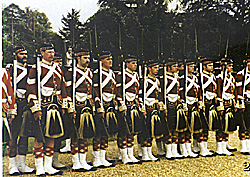 2: A close-up view of the 78th Highlanders.
Unfortunately due to the rain that dogged the events
the Highlanders were forced to abandon their feather-
bonnets at Wrest Park. The rain had caused the dye
used on the feathers to run and stain the doublets!
The standard of drill displayed was faultless and must
surely be unparalleled amongst re-created units
anywhere.
2: A close-up view of the 78th Highlanders.
Unfortunately due to the rain that dogged the events
the Highlanders were forced to abandon their feather-
bonnets at Wrest Park. The rain had caused the dye
used on the feathers to run and stain the doublets!
The standard of drill displayed was faultless and must
surely be unparalleled amongst re-created units
anywhere.
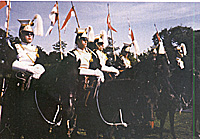 3: Troopers of the 17th Lancers about to begin
their display. These Lancers were one of the British
contingent's taking part in the events. Uniformed in
the full dress of the 1890s the Lancers are the result
of a collaboration between English Heritage, The
Troop (a multi-period cavalry re-enactment group)
and the Queens Royal Lancers who are the modern
day incarnation of the l7th Lancers.
3: Troopers of the 17th Lancers about to begin
their display. These Lancers were one of the British
contingent's taking part in the events. Uniformed in
the full dress of the 1890s the Lancers are the result
of a collaboration between English Heritage, The
Troop (a multi-period cavalry re-enactment group)
and the Queens Royal Lancers who are the modern
day incarnation of the l7th Lancers.
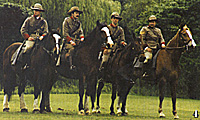 4: Troopers of the Victorian Mounted Rifles in
uniforms similar to those worn when the V.M.R. took part
in the 1897 Diamond Jubilee parade. The unit also wore
these uniforms in South Africa where they formed part of
Australia's first contingent of soldiers for service in the
Boer War. This group, who are members of the Victorian
Re-enactment Society, travelled all the way from ustralia
to join their fellow re-enactors. It is interesting to contrast
the khaki of the V.M.R. with the bright blues and reds of
the British home service uniforms. As a precursor of what
was to follow the V.M.R. had already adopted khaki as
their sole uniform colour.
4: Troopers of the Victorian Mounted Rifles in
uniforms similar to those worn when the V.M.R. took part
in the 1897 Diamond Jubilee parade. The unit also wore
these uniforms in South Africa where they formed part of
Australia's first contingent of soldiers for service in the
Boer War. This group, who are members of the Victorian
Re-enactment Society, travelled all the way from ustralia
to join their fellow re-enactors. It is interesting to contrast
the khaki of the V.M.R. with the bright blues and reds of
the British home service uniforms. As a precursor of what
was to follow the V.M.R. had already adopted khaki as
their sole uniform colour.
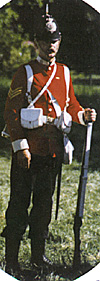 5: A sergeant of the Diehard Company, 1st Battalion
Middlesex Regiment, mid 1880s. The Diehards are one of the
British groups and are the Victorian Military Society's own re-
enactment group. Although only formed about four years ago
the tremendous progress they have made can clearly be seen
in the quality of the uniform and equipment. The uniform is
that worn following the reorganisation of the army under the
Cardwell Reforms of 1881. All the English line regiments lost
their distinctive coloured facings at this time, replacing them
with white.
5: A sergeant of the Diehard Company, 1st Battalion
Middlesex Regiment, mid 1880s. The Diehards are one of the
British groups and are the Victorian Military Society's own re-
enactment group. Although only formed about four years ago
the tremendous progress they have made can clearly be seen
in the quality of the uniform and equipment. The uniform is
that worn following the reorganisation of the army under the
Cardwell Reforms of 1881. All the English line regiments lost
their distinctive coloured facings at this time, replacing them
with white.
 6: The Diehard Company, 1st Battalion Middlesex
Regiment - Shoulder Arms. The Diehards are wearing home
service uniform but really the only change encountered for
active service, particularly in Africa, was the replacement of
the blue cloth helmet by a white foreign service helmet. The
belts are the 1882 Valise pattern with each of the pouches
on the waistbelt containing 40 rounds of ammunition.
6: The Diehard Company, 1st Battalion Middlesex
Regiment - Shoulder Arms. The Diehards are wearing home
service uniform but really the only change encountered for
active service, particularly in Africa, was the replacement of
the blue cloth helmet by a white foreign service helmet. The
belts are the 1882 Valise pattern with each of the pouches
on the waistbelt containing 40 rounds of ammunition.
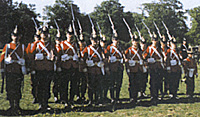 7: The Portsdown Artillery Volunteers. The P.A.V. are
uniformed members of the Palmerston Forts Society and
represent a volunteer gun crew c. 1890. Volunteer artillery
uniforms differed from the regulars by the replacement of all
brass insignia with ones of nickel silver and yellow cord
decoration with red. They were joined for the centenary by
the Heritage Interpretation Group of Malta, who wore the
uniform of the Royal Malta Fencible Artillery. Two 16pdr
R.M.L. field guns and a complete four horse team and limber
were crewed by the two groups. This was the first time a full
team and limber had been used at a re-enactment in this
country. This project was completed as a result of co-
operation between the Royal Armouries, English Heritage
and the King's Troop, RHA.
7: The Portsdown Artillery Volunteers. The P.A.V. are
uniformed members of the Palmerston Forts Society and
represent a volunteer gun crew c. 1890. Volunteer artillery
uniforms differed from the regulars by the replacement of all
brass insignia with ones of nickel silver and yellow cord
decoration with red. They were joined for the centenary by
the Heritage Interpretation Group of Malta, who wore the
uniform of the Royal Malta Fencible Artillery. Two 16pdr
R.M.L. field guns and a complete four horse team and limber
were crewed by the two groups. This was the first time a full
team and limber had been used at a re-enactment in this
country. This project was completed as a result of co-
operation between the Royal Armouries, English Heritage
and the King's Troop, RHA.
Back to Age of Empires Issue 14 Table of Contents
Back to Age of Empires List of Issues
Back to MagWeb Master List of Magazines
© Copyright 1998 by Partizan Press.
Other military history articles and gaming articles are available at http://www.magweb.com